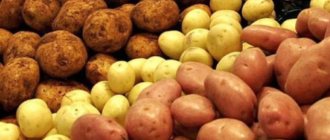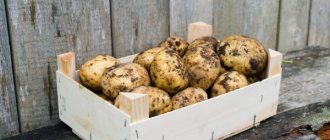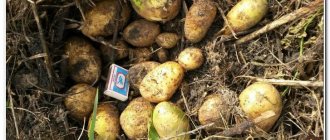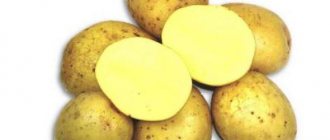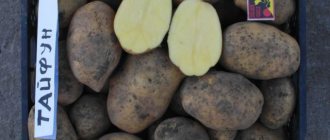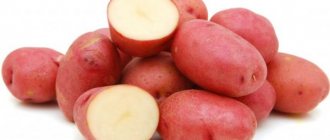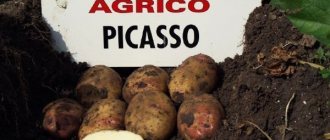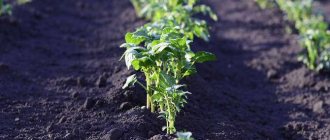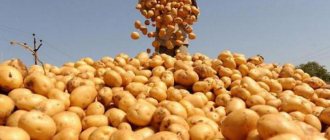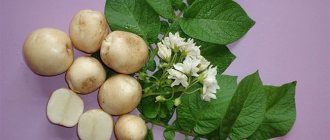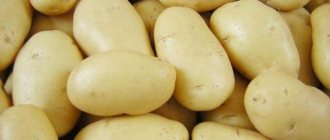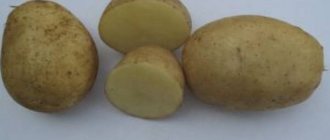Vegetable growing » Potatoes
0
1916
Article rating
Kira Stoletova
Today, potatoes are included in many dishes. At the moment, potato crops are rapidly appearing in almost every household plot. Many gardeners have stopped buying ready-made products at markets, because growing and caring for root vegetables is very simple and interesting. There are various types of potatoes that gardeners choose depending on the requirements for growing conditions and the result they want to get. The most famous and unpretentious species at the present time remains the Volat potato.
Volat potato variety
What kind of potatoes are these?
The young potato variety Volat is gaining popularity at a rapid pace. This is due to the high yield of the crop, increased resistance and excellent taste of the tubers.
Origin and development
The Volat potato variety is a new crop created by breeders from Belarus. Originator - Scientific and Practical Center of the National Academy of Sciences of Belarus for Potato and Vegetable Growing. It was included in the State Register of the Russian Federation in 2014.
Despite its short lifespan, the variety has already been chosen for commercial cultivation by hundreds of private entrepreneurs and farms. High yields combined with unpretentiousness could not help but attract the attention of those involved in vegetable growing with the subsequent sale of finished products. Farmers note increased consumer demand for vegetables not only in retail trade, but also in wholesale purchases.
Description of the variety and appearance
The purpose of ripe vegetables is for table use, average weight – 90-160 g, oval shape. There are few eyes, they are reddish in color. The peel is yellow, dense enough to protect the fruit from mechanical damage. The pulp is light yellow, the taste is high. Potatoes have a high content of protein, vitamin C (up to 30%) and other useful elements, which determines their nutritional value.
The starch content ranges from 11-19%. Ripe vegetables are ideal for frying and baking. The friability is moderate, so the tubers are often used for boiling and making purees.
Potatoes are purchased by large enterprises for further processing to make chips and fast food products. Vegetables are also used to produce starch.
The variety is suitable for long-term storage, shelf life is 94-96% of the total volume. During long-term transportation, the tubers retain their taste and presentation.
The photo shows Volat potatoes.
Mid-season varieties
Mid-season varieties of potatoes produce a harvest 100-105 days after sowing.
Dubrava
Oak grove is resistant to potato diseases: scab and potato cancer. It has round fruits of bright yellow color. The yield is 50 tons per hectare. The pulp is cream-colored, which indicates a high starch content in the tubers. The fruits fall apart when cooked.
Krinitsa
Krinitsa tubers are yellow-brown in color. The shape of the tubers is round and elongated. The variety is resistant to scab, nematode and cancer. The average yield is 49.5 tons per hectare.
The pulp is light creamy in color. The taste is good. Potatoes are grown for industrial purposes and on their own plots.
Volat
Volat is immune to scab, cancer and nematode. Produces fruits covered with yellow skin. The shape of the fruit is round or oval. Light yellow in cross section. Contains about 17-20% starch. Productivity is high; 65 tons of potatoes are harvested from one hectare of land.
Plant characteristics
The bush is of medium size, the stem is powerful, the root system is well developed. The leaves are medium-sized, rich green in color. When flowering, medium-sized white flowers are formed, collected in neat corollas.
The ripening period is average; tubers reach full technical ripeness 85-95 days after planting . The variety adapts well to drought, but is not resistant to frost.
Plants are immune to golden nematode, potato canker, diseases of viral etiology, fusarium rot and anthracnose. However, the variety does not have resistance to late blight, so preventive measures are needed.
Productivity
Productivity is the main advantage of culture . Up to 600 centners are harvested from 1 hectare, which is an order of magnitude higher than other high-yielding varieties. Therefore, Volat is a welcome guest on numerous Russian fields and in neighboring countries.
All fruits are beautiful, leveled, and resistant to damage. 98% of finished products retain their presentation.
Mid-early potatoes
Mid-early potatoes allow you to harvest root crops 92-100 days after being placed in the ground. These varieties have an average shelf life and high yield.
Lily
Lily produces medium-sized tubers with an elongated oval shape. The skin is light brown and forms a small number of shallow eyes. The pulp is dense, yellow. Liley potatoes are used for freezing and deep-frying. The pulp does not boil over and retains its shape.
A high-yielding species, produces 10-13 tubers per plant. With regular fertilizing, the amount of harvest can be increased. The fruits are medium-sized with light brown skin; when cut, the potatoes are white with a yellow tint. Yanka tolerates prolonged drought well and is resistant to spring frosts.
belongings
A high-yielding species, from 16 to 20 tubers are harvested from one bush. All tubers are smooth, almost identical, round in shape with light brown skin. The fruits are yellow inside and retain their shape when cooked. Treasures are unpretentious to soil fertility and bear fruit even on poor lands.
Read also: Original potato dishes for the exhibition
How to grow potatoes
The technology for growing potatoes comes down to standard procedures. The crop requires proper watering, timely fertilizing and hilling. The plant quickly adapts to the soil composition and climatic conditions.
Pre-sowing preparation
1 month before planting, tuber preparation begins. The optimal weight is no more than 100 g. Large tubers are pre-cut into slices.
Potatoes are carefully inspected and damaged ones are removed. The remaining seed material is laid out in a bright room for germination. Only sprouted tubers are planted, otherwise there will be no shoots. Optimum room temperature +15…+17°C.
Before sowing, the tubers are treated with a growth stimulator. The drug accelerates the emergence of seedlings and protects potatoes from fungal diseases. The most commonly used are Epin, Kornevin and Bioglobin.
By the end of germination, the tubers may acquire a greenish tint. This indicates an increased accumulation of solanine in the peel. The substance is a glycoside with toxic properties. It is best to plant green potatoes: thanks to solanine, the seed material will be reliably preserved from rodents.
Reference! Field mice are the most dangerous for planted potato tubers.
Dates, scheme and rules of planting
Volat loves light but fertile soil, so it is important to saturate it with useful substances before sowing. It is prepared in the fall by digging with the addition of humus and wood ash. In the spring the procedure is repeated. Digging not only loosens the soil, making it lighter, but also destroys the larvae of parasitic insects and fungal spores.
Planting begins in late April - early May, when the soil warms up to +10°C and the daytime temperature reaches +16...18°C. If there is a threat of return frosts or heavy rains, it is better to postpone planting so as not to ruin the seed.
Planting pattern: 35 cm – distance between holes, 70 cm – row spacing. If these conditions are met, the plants are easy to care for, they are ventilated and receive enough light, which prevents the spread of pathogens.
Potatoes are placed in holes no deeper than 10 cm. A little wood ash is placed at the bottom and sprinkled with soil on top.
Reference! When cutting large potatoes, leave at least three sprouts on each slice, otherwise there will be no sprouts.
Further care
The culture is unpretentious in care and does not require constant attention or a lot of time and effort.
Watering
Seedlings need abundant watering during flowering and fruit formation . But do not forget about the plant’s susceptibility to late blight. Excess moisture promotes the spread of fungal spores and their rapid development.
The best watering is drip. With such irrigation, the roots will not experience a lack of moisture, and the humidity level in the beds will always remain within normal limits.
After watering, loosening is carried out. Loose soil improves oxygen access to the root system, which has a beneficial effect on the development of seedlings.
Weeding beds is a necessary preventative measure in pest control. In addition, the growth of weeds consumes useful elements necessary for the life of seedlings. Weeds are removed with roots, and the beds are mulched. Mulch retains moisture in the beds and prevents the growth of new weeds.
Reference! Peat and straw are most often used as mulch.
Hilling is carried out three times per season. The procedure begins as soon as the seedlings reach 10-12 cm. The soil from the rows is raked onto the seedlings. The higher the hilling is carried out, the more the fruits are protected from sunlight and pest damage.
Feeding
Fertilizing improves crop productivity and strengthens immunity. The first one is applied as soon as the seedlings grow to 20-25 cm. If the growth of the bushes is poor, they are fertilized earlier. To do this, use nitrogenous substances or ammonium nitrate.
The second feeding is carried out at the time of flowering. During this period, seedlings need organic matter. The culture responds well to the application of bird droppings in a ratio of 1:10. The solution is spilled between the rows, after thoroughly moistening the soil.
The third time they are fertilized with a full complex of minerals. This fertilizing is applied 1 week before fruiting. Phosphorus elements and potassium substances are especially effective.
Reference! The introduction of nitrogen accelerates the growth of bushes and the growth of green mass.
Disease and pest control
The most effective and popular fungicide in the fight against late blight is Fitosporin. In addition to therapeutic, it also performs a preventive function. Many gardeners spray seedlings with this preparation from the beginning of planting. This preventive measure guarantees the health of plants in your areas.
In addition to Fitosporin, gardeners use wood ash, which is sprinkled on the bushes. It protects plants not only from fungal diseases, but also from many pests.
To combat the Colorado potato beetle, the drugs “Confidor” or “Prestige” are used, and the insecticide “Aktara” is used to control potato aphids. Another effective remedy is tobacco infusion, the smell of which repels not only aphids, but also whiteflies. The solution is prepared simply: 500 g of tobacco is dissolved in 1 liter of water and boiled for 1 hour. The concentrate is diluted in 10 liters of water and sprayed on the plants.
Reference! The natural enemy of aphids is the ladybug. Plant dill in your area to attract beetles. The ladybug actively destroys aphids until autumn.
Preparing tubers for planting
Ideally, seed potatoes must be selected in the garden. Walking through the beds, with a keen eye, highlight strong and good-quality bushes. Mark them with pegs or a tag. These bushes must be dug up separately and the middle fruits must be selected from them for seeds. For breeding, fruits weighing 40-60 grams are good. In order to plant large potatoes before cutting them, you need to adhere to certain parameters.
Related article: Potato variety “Valor” - description and photo
First, you should divide the potatoes so that at least three eyes remain in one half. Then, after any cut of the root crop, the knife must be treated with a solution of potassium permanganate (dipped in a vessel with this substance). The problem is that during this operation, the threat of infection of the fetus with viral and enterobacterial diseases increases.
Sprouting potatoes for planting
To harvest early potatoes, experts recommend germinating and greening them first. The description states that this method also helps to increase the immunity of potatoes. A sprouted species can be planted earlier; it will not be as susceptible to disease as a non-sprouted species. 3-4 weeks before disembarkation, you need to start this procedure. For this purpose, potatoes are poured into boxes in one or two rows and brought into a place with a temperature of 15-20 degrees, while at night, the planting material must be removed to a place where the potatoes will be fresher (basement or garage), in which the night temperature 5-8 degrees.
Tubers must be germinated before planting
To prevent the rudiments from being damaged, the fruits should not be exposed to direct sunlight (planting material requires diffuse light) - otherwise the rudiments will deteriorate.
By the end of the process, the germinated fruit will acquire a greenish tint, and green buds will appear on it, not exceeding 1-2 cm in length. This is a sign that the potatoes are ready for planting. Thanks to this procedure, it is possible to plant sprouted potatoes at a soil temperature of 5 degrees, while unsprouted potatoes can be planted at 8 degrees and above. Of course, the sprouts must be carefully monitored: they must be monitored to prevent unwanted growth in length. If you see that the sprouts have grown to the required length, and sow only after a couple of weeks (similar things happen), place the container with the sprouted potatoes in the cellar, then the germination process will slow down.
Collection, storage and use of crops
Before harvesting, it is advisable to mow the tops. The foliage is burned because it may contain pests.
Potatoes are dug up with a pitchfork or shovel, then left on the site for 2-3 hours to dry completely. The harvest is then placed in wooden boxes for storage. The room chosen is dry and cool.
The shelf life of the finished product is high; almost the entire harvest retains its presentation until spring.
Ripe tubers are used in cooking as widely as your imagination dictates. The fruits are ideal for preparing any dish, including baking and stewing.
Large enterprises purchase potatoes for further processing and production of chips and fast food. The tubers are also used to make starch.
This is interesting:
What are the dimensions of the largest potato in the world and who grew it.
Mid-early resistant potato variety "Satina".
Late ripening varieties
Tubers ripen on the 124-133rd day of the growing season. These varieties have strong immunity.
Stonefly
Produces medium and large fruits. They are covered with thin skin of light brown color. In cross section, the root crop is light yellow. Stonefly exhibits good keeping quality, immunity to infections and resistance to dry periods.
Rogneda
Tall bushes are developing. The fruits are large, light brown in color. The pulp is bright yellow, dense. Does not lose its shape when cooked. The peculiarity of the variety is that it can be dug up unripe. Rogneda exhibits good keeping quality, the fruits retain their shape without changes until the beginning of the next season.
Advantages and disadvantages
Among the many advantages of the Volat variety:
- possibility of breeding in all regions;
- adaptation to drought and soil composition;
- possibility of quick implementation;
- ease of care;
- high resistance;
- increased productivity;
- excellent taste of fruits;
- long preservation of presentation;
- duration of transportation;
- universal application.
One of the negative qualities is susceptibility to late blight.
For which regions is it best suited?
The culture has become widespread in Russia, Belarus, Kazakhstan, Ukraine and the Republic of Moldova. But it is preferable to plant the variety in regions with light and fertile soil.
Farmer reviews
Reviews about potatoes come not only from Russian gardeners, but also from neighboring countries. Here are some opinions:
Ilya, Minsk: “From the characteristics of Volat potatoes it follows that all agricultural technology comes down to several standard procedures. The way it is. I am a farmer, I have been growing vegetables for a long time, and minimal costs for cultivating fields are very important to me. Ripe vegetables are in excellent demand. The taste of potatoes is amazing, so I not only sell the harvest, but also definitely keep it for the winter.”
Ekaterina, Moscow: “Last year I saw a photo on the Internet, read the characteristics and decided to plant it on my site. I have a small garden, so I always wanted a productive crop. Volat did not disappoint. There were a lot of potatoes, all smooth, beautiful and tasty. I recommend it to everyone."
